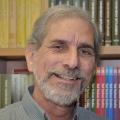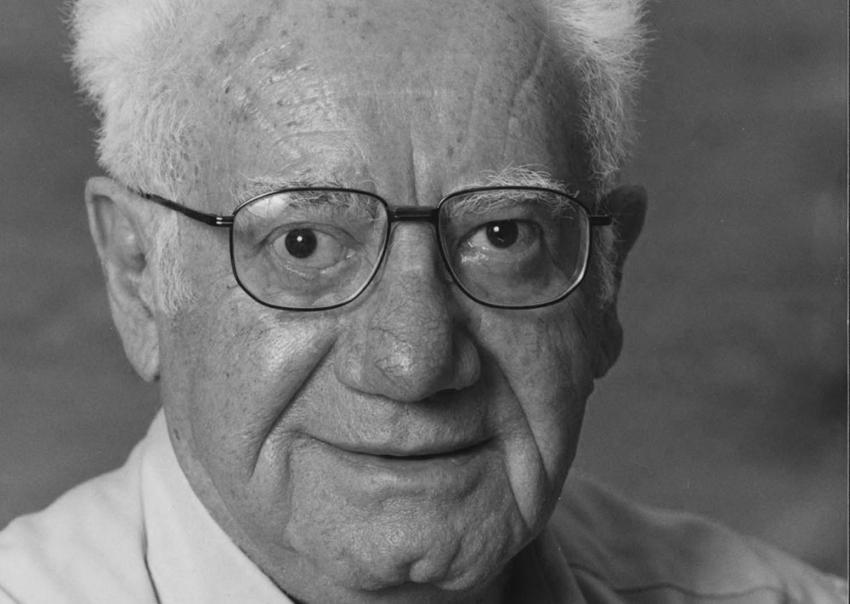Volume 41:2 of Yad Vashem Studies is dedicated to the memory of Professor Yisrael Gutman, one of the towering figures of Holocaust research, who passed away as we were completing the editing of this issue. Yisrael was one of my first teachers when I began my graduate studies, and from the first moment he was always an inspiration as well as one of my mentors. His meticulous research, deep insight, unusually vast knowledge, and eminent humanity were a model for all his students and for all scholars. One of the many aspects of the study of the event on which he had a seminal impact is his research and teaching approach that centered on the Jews in the Holocaust. He approached the study of Jews’ responses to the Holocaust with sympathy and empathy, yet at the same time critically and without mythologizing. Indeed, much of the scholarly community that researches and teaches the Holocaust are to one degree or another students of Yisrael Gutman.
Yisrael was a member of the Editorial Board of Yad Vashem Studies for four decades, and in the spring of 1996 he turned to me to take on the job of editor when Aharon Weiss announced his retirement. I had the good fortune to work with Yisrael in various capacities and on diverse projects, as well as in academic conferences. From the very beginning, he related to me not as a young student or beginning scholar, but as a peer, even when we disagreed on one historical point or another. He was remarkably adept at balancing human involvement and scholarly distance, and this was even more remarkable in light of his personal background during the Holocaust. There are those times in a person’s life when one is given the rare privilege of getting to know greatness up close, someone whose influence can shift the tides of thought and affect people across the globe. Yisrael Gutman was one of those giants, and the world is a much dimmer place without him.
Many people would have liked to contribute their thoughts on Yisrael Gutman to this issue. Unfortunately, we cannot provide adequate space to everyone. We have turned to Yehuda Bauer, Yisrael’s close friend and colleague who together with him built Holocaust research in Israel; Otto Dov Kulka, who was also one of the central players in developing Holocaust research in this country; and Havi Dreifuss, who in her closeness to Yisrael and in her research interests and approach is in many ways his last student and torchbearer. Yehuda Bauer and Dov Kulka relate personal reflections on Yisrael and their shared projects together, while Havi Dreifuss analyzes his research and contribution to the scholarship on the subject. The personal insights of Yehuda and Dov reveal sides to the man with which many readers might be unfamiliar. Havi demonstrates the influence of Yisrael’s personal experiences — in the Hashomer Hatzair youth movement and the Warsaw ghetto uprising; in Majdanek, Auschwitz, and Mauthausen; and in the postwar period — on his work, as well as the influence of three figures from Warsaw whose personalities and ideas guided him throughout his career — Mordechai Anielewicz, Janusz Korczak, and Emanuel Ringelblum. Together, these articles provide keen insights into the man and his impact on the field of Modern Jewish History and the Holocaust.
The research and review articles in this issue cover a wide gamut of subjects from the perspectives of a variety of disciplines — archaeology, history, social sciences, philosophy, law, and literature. Yoram Haimi and Wojciech Mazurek apply a new scholarly approach to Holocaust research — archaeology — in order to uncover more of the story of the Sobibór extermination camp and unravel some of its mystery. The Jewish prisoner revolt and mass escape on October 14, 1943, was followed by the German destruction of the camp, making the identification of the camp’s sections, the mass burial pit, and other central aspects of the camp extremely difficult over the years. This in turn has helped obscure important parts of the camp’s history and daily life. In their six years of excavating so far, Haimi and Mazurek have successfully determined the actual layout of most of the camp, which differs from the maps and drawings to date, as well as from what had been presented at the site itself to commemorate the events there. They have also unearthed numerous artifacts that aid us in understanding various aspects of life and death there; one of those artifacts appears in the cover photo of this issue.
Avihu Ronen looks at two major aspects of a significant yet littleknown June 1943 telegram sent by Yitzhak Tabenkin, leader of Hakibbutz Hameuchad, calling on the armed underground in the Będzin ghetto to forgo their revolt plan and do all they could to save themselves. Leaders of the underground rejected these instructions, which they saw as abandoning the community and their ideals. For decades the very existence of this telegram was doubted, since the original has not yet come to light. Ronen brings much factual evidence to demonstrate that the telegram did exist, was sent from Mandatory Palestine, and reached its destination. In the process he analyzes both the debate that ensued between the young fighters in Będzin and their movements’ leadership in Palestine, and the quashing of this document and its implications in postwar Israel. Ronen’s astute analysis of these issues sheds light on both the sometimes radically different perspectives of people in the midst of the murder versus people outside, and the ideological atmosphere in Israel in its first years.
Devin Pendas, Laura Jokusch, and Gabriel Finder analyze the place of the Jews in three postwar trials relating to Auschwitz and find that contrary to prior belief, the murder of the Jews played a significant role in the proceedings. This was true at the 1945 British trial of Bergen-Belsen SS perpetrators at Lüneburg, many of whom were previously at Auschwitz-Birkenau and hence that camp became central in the trial. The Jews also figured prominently in the trial of AuschwitzBirkenau commandant Rudolf Höss in Poland in 1947, and in the 1963 to 1965 Frankfurt Auschwitz trial. Moreover, the testimonies heard in these trials regarding the suffering of the Jews at the camp helped form the iconic images of Auschwitz. The analysis of these trials also helps us to understand why Auschwitz-Birkenau became the symbol of the Holocaust.
Samuel Lederman and Noga Wolff address the work of two thinkers, respectively, the political philosopher Hannah Arendt and historian Uriel Tal, who both profoundly influenced Holocaust research. Lederman sets out to demonstrate that Arendt’s “banality of evil” concept has been misunderstood in Holocaust historiography. When other of her writings that relate to this concept though not directly to the Shoah are taken into account, it becomes clear that she did not mean that Eichmann’s actions were “ordinary,” nor were his crimes “bureaucratic” or gray. Rather, Arendt’s concept of thoughtlessness helps to clarify her meaning regarding the term “banality of evil.” The article goes on to examine Arendt’s concept against recent historical research.
Noga Wolff skillfully navigates Uriel Tal’s personal archive in order to analyze his understanding of antisemitism. She focuses on one of the key components that Tal believed was at the core of antisemitic ideology — its rejection of the ideas of the critical Enlightenment. Tal showed both in his publications and in his extensive correspondence with scholars around the world that rejection of the principles of the Enlightenment is a common factor underlying the arguments of antiJewish and antisemitic parties and movements, whether explicit or hidden, from the late nineteenth century through the Nazi rise to power. Wolff argues that this interpretation of the role of anti-Enlightenment thinking challenged conventional theories of Israeli and Jewish historiography.
The review section of this issue includes five critiques of books that appeared in five countries and cover a broad spectrum of topics. Antony Polonsky says that Dariusz Libionka and Laurence Weinbaum’s book, Bohaterowie, hochsztaplerzy, opisywacze: Wokół Żydowskiego Związku Wojskowego, is a tour de force, the first serious examination of both the history and the consistent falsification in both Poland and the Jewish world of the role of the Revisionist Zionist armed underground, the Jewish Military Union (ŻZW), in the Warsaw ghetto uprising. Avinoam Patt reviews Amos Goldberg’s Trauma in the First Person: Diary-Writing during the Shoah (Hebrew), a valuable and incisive contribution that calls on scholars to re-examine autobiographical texts from the Shoah through the lens of trauma, showing that diaries enabled their writers to maintain some sense of identity as their world crumbled around them. Robert Jan van Pelt is very critical of Florent Brayard’s Auschwitz: Enquête sur un Complot Nazi and its argument that Hitler, Himmler and some other top Nazis conspired to keep the murder of German and West European Jews secret even from many other senior Nazis, such as Josef Goebbels, until the fall of 1943. Yehuda Bauer finds Götz Aly’s new book on the Nazi “euthanasia” program, Die Belasteten: “Euthanasie” 1939–1945: Eine Gesellschaftsgeschichte, to be a very important, multi-faceted work that uncovers a deeply buried secret that both the German establishment and public preferred to repress even many years after the war. And Miriam Trinh reviews David G. Roskies and Naomi Diamant, Holocaust Literature: A History and Guide, praising its richness, diversity, and value as an educational tool for a younger audience. Also, it successfully shifts attention away from the symbolic epicenter of the Shoah, Auschwitz, and refutes the widely held view that no meaningful literary discourse on the Shoah took place during or immediately after the event.
Sobibór, the dilemmas and true stories of ghetto undergrounds, the centrality of Jews in the story of Auschwitz-Birkenau, theories regarding perpetrators and modern antisemitism, Shoah diaries and literature, and the Nazis’ “euthanasia” program were all subjects that acutely engaged Yisrael Gutman. Indeed, he published eminent works on most of these subjects and deeply influenced our understanding of them. This edition is one we all hope serves his memory well and one with which I believe he would have been most pleased.


